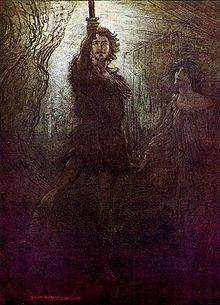Sigmund
This article needs additional citations for verification. (June 2015) |

In
Völsunga saga

In the Völsunga saga, Signý marries
He then lets his shapeshifting mother turn into a wolf and devour one of the brothers each night. During that time, Signý tries various ruses but fails every time until only Sigmund remains. On the ninth night, she has a servant smear honey on Sigmund's face and when the she-wolf arrives, she starts licking the honey off and sticks her tongue into Sigmund's mouth, whereupon Sigmund bites her tongue off, killing her. Sigmund then escapes his bonds and hides in the forest.
Signý brings Sigmund everything he needs. Bent on revenge for their father's death, she also sends her sons to him in the wilderness, one by one, to be tested. As each fails, she urges Sigmund to kill them, until one day when he refuses to continue killing innocent children. Finally, in despair, she comes to him in the guise of a
Sigmund and his son/nephew, Sinfjötli, grow wealthy as
After Signý dies, Sigmund and Sinfjötli go harrying together. Sigmund marries a woman named Borghild and has two sons, one of them named Helgi. Sinfjötli slays Borghild's brother while vying for a woman they both want. Borghild avenges her brother by poisoning Sinfjötli.
Later, Sigmund marries a woman named
Relation to other Germanic heroes
Sigmund/Siegmund is also the name of Sigurd/Siegfried's father in other versions of the Sigurd story, but without any of the details about his life or family that appear in Norse Völsung tales and poems. On the other hand, the Old English poem Beowulf includes Sigemund the Wælsing and his nephew Fitela in a tale of dragon slaying told within the main story. Herein the story of Sigemund is told to Beowulf, a warrior also from Gautland.
Parallels
Parallels to Sigmund's pulling the sword from the tree can be found in other mythologies (notably in the Arthurian legends). Also, Sinfjötli and Mordred share the characteristic of being nephew and son to the main characters. The gaining of mythical powers through a sword is also similar to the Norse god Frey.
In modern fiction
Siegmund is a character in
The story of Sigmund, beginning with the marriage of Signy to Siggeir and ending with Sigmund's vengeance on Siggeir, was retold in the novelette "Vengeance" by Arthur Gilchrist Brodeur, which appeared in the magazine Adventure, June 30, 1925. Brodeur was a professor at Berkeley and became well known for his scholarship on Beowulf and Norse sagas.
See also
Notes
References
- Orchard, Andy (1997). Dictionary of Norse Myth and Legend. ISBN 0-304-34520-2

